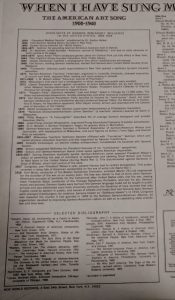African-American composers and performers have long been disregarded and ignored in the American music industry. But visibility and exposure are the not the only problems they have faced; even when performances or recordings featured music by African-American composers, for example, they often did so in a way that presented these works as peripheral.
While searching through old articles written in The Manitou Messenger, one particular review of a vocal performance stuck out to me. The article is a review of a Canadian baritone, Cameron McLean, who performed at St. Olaf on December 6, 1923. Apart from several unintentional roasts by the author (“It was pleasing, but not especially brilliant”), one of the opening descriptions of the repertoire caught my eye. The author details the program, saying “His native Scotch songs were features of the program, although he presented several from other sources, Italian, American, Russian and German. One negro spiritual was also included.”1
Listing the spiritual song as separate from all of the other pieces featured is just one example of a way music by African-Americans was othered even when it was performed. By all rights, the spiritual should be included in the previously mentioned category of “American music,” but instead, it is viewed as something different that must be mentioned on its own. In addition to this, the actual content of the review specifically calls out the two spiritual-esque songs, “The Gospel Train” and “Goin’ Home” as weaker parts of the performance.2 It could very well be that the reviewer just thought the McLean did not connect with these pieces as well or that his performance was technically weaker, but I suspect the author had a personal and societally enforced bias against these songs.
Though it came earlier in time, an album of “American Art Songs” found in the music library was less blatant in its othering of African-American spirituals. The album, called “When I Have Sung My Songs,” features twenty art songs by American composers, including three by H. T. Burleigh.3 While these three are not blatantly treated any differently than the rest of the songs on the record, the cover material does seem to set them apart a bit. There is a large informational timeline entitled “Highlights of German Immigrant Influence in the United States, 1859-1918” that takes up half of the back cover. Digging deeper into the other composers featured in the album, I found that the majority had connections to Germany. From Edward MacDowell, who studied in Germany, to Walter Damrosch, who was born in Germany, it seemed like German-influenced American composers were the theme of the album, with African-American composers such as H. T. Burleigh and J. Rosamond Johson once again conspicuously outsiders.
Clearly, even when African-American composers did begin to gain a little attention and exposure in the American classical music scene, the battle was not won. The early twentieth century may have allowed them to have a corner of the spotlight, but the way they were presented still made it clear that they did not fully belong.
Footnotes:
1 “Music Review”, The Manitou Messenger (1916-2014), No. 13, Vol. 037, December 11, 1923, page 4.
3 When I Have Sung My Songs: The American Art Song 1900-1940, New World Records, 1976.
Works Cited:
“Music Review”, The Manitou Messenger (1916-2014), No. 13, Vol. 037, December 11, 1923, page 4. https://stolaf.eastview.com/browse/doc/45684447, Accessed October 30, 2019.
When I Have Sung My Songs: The American Art Song 1900-1940, New World Records. 1976, Recorded Anthology of American Music, Inc.


